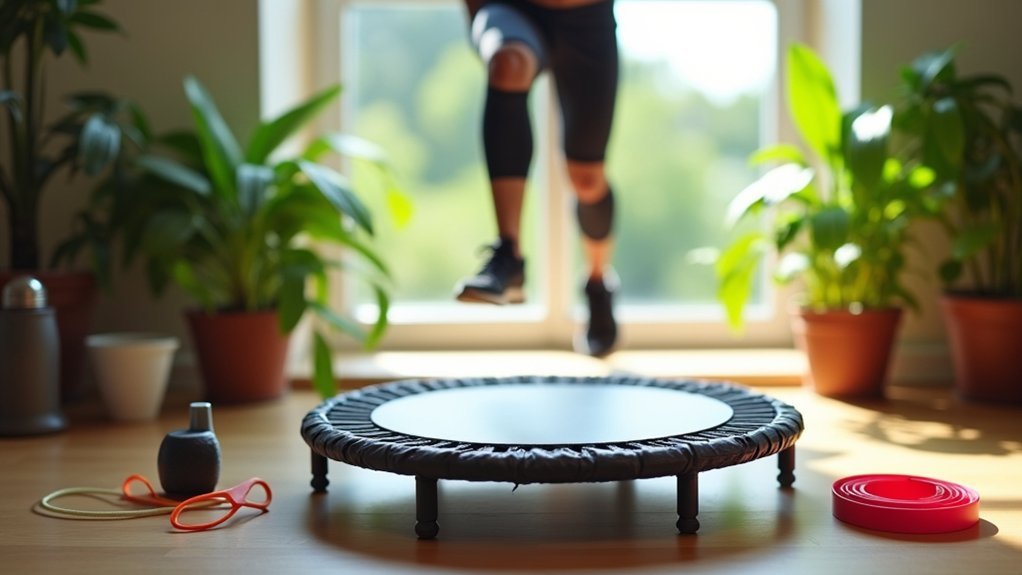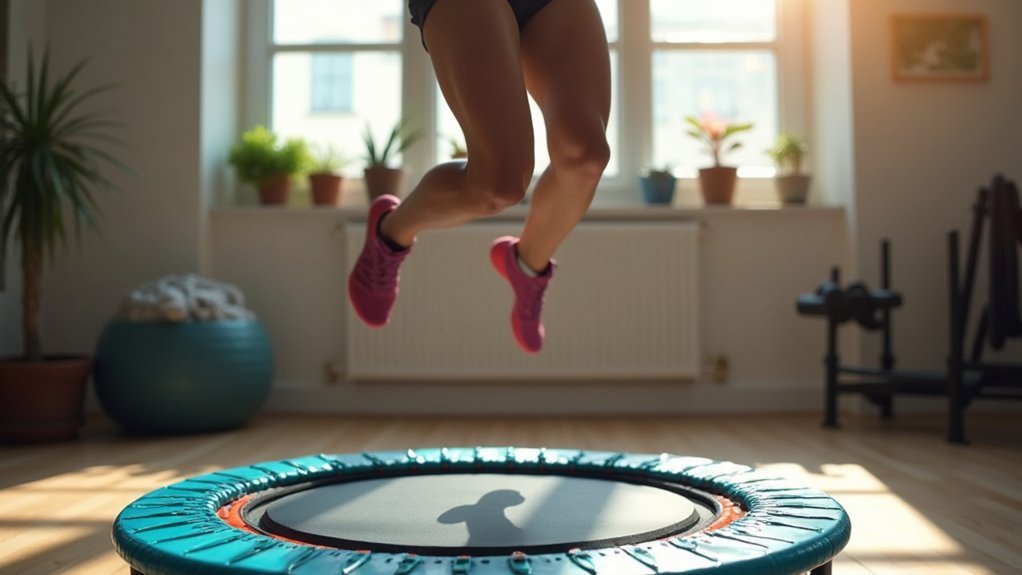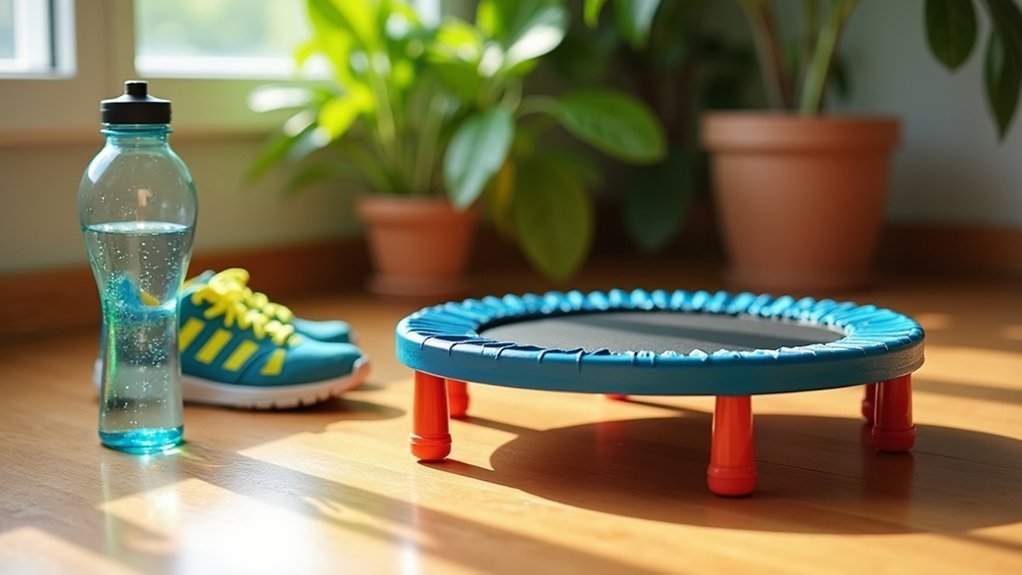To maximize glute activation on your mini trampoline, focus on three key techniques: maintain a heel-focused weight distribution instead of bouncing on your toes; position your feet slightly wider than hip-width with toes angled outward 10-15 degrees; and incorporate mini squats driving through your heels rather than shallow knee bends. These adjustments shift the workload from your calves and quads directly to your glutes. Discover how proper form transforms ordinary bouncing into effective posterior chain training.
Why Mini Trampolines Are Ideal for Glute Training

While traditional glute exercises often put stress on your knees and ankles, mini trampolines offer a rejuvenating alternative that’s both effective and joint-friendly.
These compact rebounders create a low-impact environment where you can strengthen your glutes without the jarring effects of floor exercises.
When you bounce, your entire body engages to maintain stability, with your glutes working overtime during each takeoff and landing.
You’ll notice improved balance and coordination as your body adapts to the dynamic surface.
The fun, bouncy nature of trampoline workouts also keeps you motivated to continue your routine consistently.
The space-saving design means you can work your glutes year-round regardless of weather, making mini trampolines a practical addition to your home fitness equipment.
Exercises like the Bounce Down specifically target and activate your core, glutes, and hamstrings while maintaining the low-impact benefits of rebounding.
The Science Behind Rebounding and Muscle Activation
Understanding what happens to your body during rebounding reveals why mini trampolines are so effective for glute training. When you bounce, your muscles continuously contract against gravity’s changing forces, stimulating muscle spindles that enhance tone and activation particularly in your glutes.
Research shows rebounding delivers multiple physiological benefits:
- Improves proprioception and coordination by stimulating neurological pathways
- Enhances muscular strength as evidenced by improvements in 1-RM and 20-RM tests
- Increases vertical jump performance through specialized lower limb muscle activation
The gravitational stress experienced during rebounding is key—it stimulates osteoblastic activity for bone health while creating the perfect environment for muscle development.
This gravitational component makes rebounding uniquely effective compared to traditional exercises, especially for targeting the glute muscles. The exercise can be particularly enjoyable while delivering significant cardiorespiratory benefits, as participants in studies reported lower perceived exertion than the actual workout intensity.
Proper Foot Positioning for Maximum Glute Engagement

Proper foot positioning on your mini trampoline can make or break your glute workout effectiveness. To maximize posterior chain activation, maintain a heel-focused weight distribution while keeping feet flat on the surface.
Angle your toes slightly outward (10-15°) during wide stances to engage your glute medius.
Vary your stance width strategically – use hip-width spacing for gluteus maximus work and wider positions (1.5x shoulder width) to target medius and minimus muscles.
For advanced activation, try elevating your heels on the rebounder edge during hip thrusts or incorporating single-leg bounces for unilateral development, similar to the single leg extension exercise performed in a kneeling position.
During dynamic movements, control your touchdown after jumps to maximize eccentric loading.
Incorporate lateral weight shifts and tempo variations to maintain muscle confusion and optimize both strength and power development.
Mini-Band Integration for Enhanced Glute Recruitment
Integrating mini resistance bands with your trampoline routine creates a powerful synergy that dramatically enhances glute activation. Position bands just above your knees during lateral shuffles and jump squats to target your gluteus medius and maintain proper knee alignment throughout your movements.
For maximum recruitment, try these strategic band placements:
- Above-knee positioning during lateral movements to fire up medius/minimus muscles
- Diagonal tension configurations for transverse plane activation
- Double-loop setups (thighs and ankles) for compound muscle engagement
Pre-activate your glutes before rebounding with clamshells against the trampoline frame or seated band abductions at the edge. Underactive glutes can lead to compensatory patterns and increased injury risk during high-impact trampoline exercises.
For recovery, incorporate banded marches on the rebounder and progress through different band thicknesses as your strength improves.
Progressive Resistance Techniques on Your Rebounder

Progressive resistance transforms ordinary rebounder workouts into glute-sculpting powerhouses that continuously challenge your muscles. By systematically increasing difficulty, you’ll prevent plateaus while maximizing glute activation. These workouts provide low-impact intensity that protects your joints while still delivering powerful glute-building benefits.
| Technique | Benefit | Progression Example |
|---|---|---|
| Variable Bounce Intensity | Targets different muscle fibers | Low bounces → High jumps |
| Unilateral Loading | Addresses muscle imbalances | Staggered stance → Pistol squats |
| Tempo Manipulation | Increases time under tension | 3-second descent → Explosive up |
| HIIT Integration | Maximizes metabolic impact | 20:40 intervals → 30:30 ratios |
| Equipment Synergy | Adds external resistance | Bodyweight → Bands → Weights |
For ideal results, master bodyweight stability before adding resistance bands or weights. Incorporate single-leg movements like staggered stance bounces and lateral limb loading to isolate each glute separately while maintaining core engagement.
Combining Weighted Movements With Bounce Dynamics
The power of weighted movements amplifies your mini trampoline workout, creating a synergistic effect that targets your glutes with unprecedented intensity. Select adjustable weights (5-25 lbs) for hip thrusts and squats while maintaining heel-driven rebounds to activate your posterior chain. This workout structure follows a circuit style approach with five distinct circuits for maximum efficiency.
For maximum results, implement these strategic pairings:
- Bounce-to-squat sequences: alternate 60 seconds of tuck jumps with 20 weighted squats
- Weighted bridges with feet positioned on the trampoline’s edge for deeper glute activation
- Lateral shuffle rebounds paired with banded crab walks to specifically target your gluteus medius
Follow a 1:3 cardio-to-strength ratio (60s bounce → 180s glute work) and incorporate 2-second pauses at peak contraction to maximize muscle engagement during weighted movements.
Common Form Mistakes That Minimize Glute Activation
While perfecting your mini trampoline technique might seem straightforward, subtle form errors can dramatically reduce glute engagement, turning what should be a posterior-focused workout into an inefficient exercise.
Jumping upward rather than down shifts work to your quads instead of activating your glutes. Bouncing on your toes creates an anterior weight shift that promotes calf dominance over posterior chain engagement.
To maximize glute activation, drive downward through heels instead of bouncing upward on toes—otherwise, your quads and calves take over.
You’ll also lose activation with shallow knee bends and vertical torso alignment that eliminate proper hip hinge mechanics. Tight hip flexors inhibit glute firing through reciprocal inhibition, while inadequate core bracing causes energy leaks throughout your kinetic chain. Focusing on maintaining a neutral pelvis position while engaging your lower abs will prevent hip flexor tension that restricts proper glute activation.
Without proper diaphragmatic breathing and intra-abdominal pressure, you’ll sacrifice power and proper alignment. Remember that rebounding should involve controlled loading, not just passive bouncing on the trampoline’s surface.
Creating an Effective Glute-Focused Rebounding Circuit
Design your mini trampoline workout by alternating 60-second bounce sequences with 30-second squat variations to maximize glute engagement.
You’ll want to progressively increase intensity by adding resistance bands or weights as your muscles adapt to the demands of rebounding. For optimal muscle activation, maintain proper posture with chest and eyes up throughout each exercise.
Allow 60-90 seconds of recovery between each circuit to maintain proper form while keeping your heart rate elevated for ideal fat-burning and muscle-building benefits.
Alternating Bounce-Squat Sequences
Alternating between dynamic bounces and focused squats creates one of the most effective mini trampoline workouts for your glutes.
This combination maintains constant muscle activation while maximizing time under tension, particularly when you maintain a neutral spine during bounces and drop your hips below parallel during squats.
Structure your intervals for best results:
- Use 40-second work periods with 20-second rests for muscle growth
- Incorporate wide-stance positions with toes angled outward to target gluteus medius
- Add arm movements during bounces to increase core engagement and caloric burn
Each exercise can be performed for 45 seconds followed by 15 seconds of active recovery for optimal intensity and adequate rest.
Progress through five distinct phases, starting with basic bounces and advancing to single-leg shifts.
Remember to maintain proper pelvic alignment by slightly tucking your tailbone during squats to fully isolate and activate your glutes.
Progressive Loading Strategy
Building an effective rebounding circuit for your glutes requires a strategic approach to progressive loading. Start with a proper warm-up of light bouncing before gradually increasing intensity to prevent injuries and allow your muscles to adapt.
Structure your circuit with variety—incorporate marching, lateral bounds, mini squats, and single-leg bounces to target your glutes from multiple angles. Balance high-intensity intervals with recovery periods, adjusting rest times based on your fitness level. The feeling of freedom and vitality that comes from rebounding exercises mirrors the symbolic wind and sun imagery in modern music.
As you advance, increase workout frequency, extend duration, or add resistance bands for greater challenge. Remember to customize exercises to your abilities while maintaining consistency.
Conclude each session with gentle stretches to improve flexibility and reduce soreness. This progressive approach guarantees your muscles, particularly the glutes, continually develop strength and endurance while keeping bones healthy.
Recovery Between Circuits
Effective recovery periods between rebounding circuits can make or break your glute-focused workout. Aim for a 1:3 work-to-recovery ratio, giving your muscles time to reset while maintaining circulation through low-intensity bouncing or gentle marching for 30-60 seconds.
Between your intense rebounding sets, incorporate these targeted recovery movements:
- Standing hip CARs (controlled articular rotations) to improve hip capsule function
- Thread-the-needle stretches on the rebounder mat to address internal hip rotation
- Mini band lateral steps to activate your glute medius without overloading
Don’t forget to integrate breathwork using a 4-7-8 pattern to stimulate parasympathetic recovery. For optimal recovery, maintain a soft knee position while doing your gentle bounces to reduce impact on joints and promote better blood circulation.
Stay hydrated with low-carb electrolyte drinks every two circuits, supporting muscle elasticity and preventing cramping during these glycogen-replenishment phases.
Recovery and Stretching Protocols for Glute Development
After your trampoline session, spend two minutes using a foam roller on your glute muscles to release fascial restrictions and improve tissue quality.
You’ll notice immediate relief as you target tight spots with gentle pressure, helping your muscles recover faster for your next workout.
Follow this with a quick mobility sequence that includes figure-four stretches and pigeon pose variations to maintain flexibility and prevent the tightness that can limit your rebounding performance. Holding each stretch for 20-30 seconds provides optimal time for the muscles to relax and elongate while enhancing your overall range of motion.
Two-Minute Fascia Release
While traditional rebounding exercises build explosive power, integrating a two-minute fascia release protocol before your mini trampoline workout can dramatically enhance glute activation and recovery.
Focus on cross-fiber rolling by sitting on a foam roller and leaning to one side, targeting your gluteus maximus with perpendicular movements. Roll back and forth to ensure thorough coverage of the muscle surface.
For deeper tension relief, spend 30-60 seconds applying targeted pressure to restricted areas using a tennis ball. You’ll reveal better biomechanical function, reducing strain on your SI joints during trampoline work.
- Use a tennis ball for precise pressure on your gluteus medius near the iliac crest
- Modify pressure by shifting your leg position or using a softer tool
- Perform gentle leg circles while maintaining pressure to enhance mobility
This brief release optimizes your kinetic chain alignment for more effective bouncing.
Post-Bounce Mobility Sequence
The post-bounce mobility sequence serves as your critical bridge between intense trampoline work and optimal glute development.
Start with dynamic hip circles to restore range of motion, followed by gentle contralateral movements that mimic natural walking patterns.
Incorporate side plank clamshells to target your gluteus medius while foam rolling releases tension in overworked muscles.
Don’t skip the piriformis stretch – this often-neglected area can limit your glute activation when tight.
Complete your recovery with single-leg balance exercises that continue engaging stabilizing muscles while promoting blood flow.
Remember to hydrate thoroughly during this sequence to support muscle recovery.
This structured approach prevents post-workout stiffness while simultaneously preparing your glutes for ideal growth during the recovery phase, ensuring you’ll bounce back stronger for your next session.
Rather than relying on passive flexibility, focus on developing active mobility through controlled movements that integrate your entire hip structure.
Advanced Unilateral Exercises for Addressing Muscle Imbalances
Unilateral exercises on a mini trampoline offer an exceptional way to address muscle imbalances that might be hindering your fitness progress. The unstable surface intensifies core engagement while targeting your weaker side.
Try single-leg squats or lunges on your trampoline, guaranteeing your knee maintains a 90-degree angle for proper form. This approach is especially beneficial for people with scoliosis or imbalances.
For maximum benefit, focus on:
- Single-leg glute bridges to isolate and strengthen imbalanced glute muscles
- Split squats with your rear foot on the trampoline to increase stabilization challenges
- Single-leg deadlifts using the opposite hand for balance while maintaining proper pelvic alignment
Working with a trainer initially guarantees correct technique.
Be patient and consistent—muscle balance takes time but delivers improved stability, reduced injury risk, and enhanced overall performance.
Frequently Asked Questions
Can I Use a Mini Trampoline if I Have Previous Knee Injuries?
Yes, you can use a mini trampoline with previous knee injuries. Choose quality rebounders with bungee systems, maintain proper form with bent knees, start gradually, and get medical clearance from your physical therapist first.
How Long Should Beginners Rebound Before Adding Resistance Bands?
You should rebound for a few weeks before adding resistance bands. Start with 5-30 minute sessions without weights until you’re comfortable with basic movements and have built foundational strength and stability.
Will Rebounding Workouts Affect My Pelvic Floor Strength?
Rebounding can strengthen your pelvic floor muscles when done correctly. Start with gentle bounces, maintain proper posture, and listen to your body. If you have existing pelvic floor issues, consult a healthcare professional first.
Does Trampoline Size Impact the Effectiveness of Glute Exercises?
Yes, trampoline size does impact glute exercise effectiveness. Smaller mini trampolines offer more controlled movements focusing on glute muscles, while larger ones provide higher bounces that can increase intensity and muscle engagement.
Can Mini Trampoline Workouts Replace Traditional Barbell Hip Thrusts?
No, mini trampoline workouts can’t fully replace barbell hip thrusts. You’ll get different benefits—trampolines offer low-impact, dynamic training while barbells provide superior progressive overload and targeted glute strengthening that trampolines can’t match.
In Summary
When you’re consistent with these rebounding exercises, you’ll notice firmer, stronger glutes that support your daily activities and athletic performance. Don’t forget to increase the challenge as your strength improves. By maintaining proper form, adding resistance, and following recovery protocols, your mini trampoline becomes a powerhouse tool for glute development. Keep bouncing with intention, and you’ll transform your lower body strength.





Leave a Reply